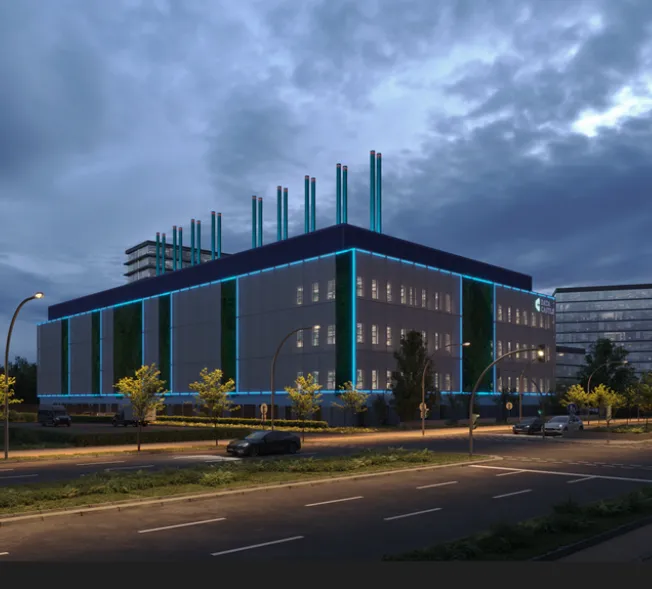For many years, the focus of data centre development has been primarily on internal operations: improving energy efficiency, enhancing cooling systems, and scaling for the ever-growing demands of computing. However, with the increasing importance of sustainability and technology in shaping the future, exterior design is becoming just as critical as what’s happening inside these facilities. The architectural and aesthetic decisions made in designing data centres now have the potential to impact brand identity, environmental performance, and the relationship with the surrounding community.
Shaping Brand Identity
Data centres are no longer seen as mere, anonymous storage spaces for digital information. As they grow in number and size, they are becoming more visible representations of the companies that operate them. Whether it’s a large tech giant or a cloud service provider, the design of their data centres can serve as an extension of their brand identity.
An innovative and well-crafted exterior not only communicates technological expertise but can also signal a company’s commitment to sustainability, professionalism, and forward-thinking. A modern, eye-catching facility may project an image of technological strength and innovation, while a design that integrates sustainable architecture could reinforce a company’s commitment to environmental responsibility. This thoughtful integration of design and technology helps enhance the public image of the business, boosting customer trust and making a positive impression on investors and partners.
For example, major corporations are increasingly opting for designs that align with their core values. Google’s data centres often boast cutting-edge eco-friendly features and sleek, contemporary designs. Microsoft, on the other hand, is exploring how modular, sustainable designs can be incorporated into its data centre operations. This shift highlights the growing importance of how exterior designs align with corporate values and environmental goals.
Reducing Environmental Impact
As climate change and environmental sustainability become critical issues worldwide, data centres have come under increasing scrutiny regarding their environmental impact. While the interior of a data centre is focused on functionality—energy consumption, cooling systems, and computing power—the exterior can play a crucial role in achieving sustainability goals.
Architectural elements such as green roofs, solar panels, reflective surfaces, and living walls not only enhance the visual appeal of data centres but also help reduce their environmental footprint. These features can contribute to energy efficiency, support biodiversity, and reduce water consumption. Some companies are even installing rooftop beehives to demonstrate a commitment to ecological balance.
Additionally, landscape choices surrounding the data centre play an important role in improving environmental performance. Proper landscaping can help with water retention, reduce runoff, and create a more natural environment for wildlife. In certain cases, designing the building with natural ventilation and minimizing the use of harmful materials can significantly lower the carbon footprint of the facility. These design choices don’t just reflect well on the company’s environmental credentials—they also ensure that the data centre contributes to local biodiversity and environmental health.
Building Better Community Relations
While data centres are essential infrastructure, they are not always welcomed with open arms by local communities. There are often concerns about the environmental impact, the size of the building, and how it might affect the neighborhood’s aesthetic value. In some instances, these concerns have led to pushback from residents or even legal challenges against development projects.
This is where thoughtful exterior design can help ease tensions and improve community relations. By designing data centres that blend seamlessly with their surroundings—whether through the use of local materials, landscaping, or architectural styles that match the area’s character—the building becomes less of an eyesore and more of an accepted part of the community. For example, many data centres built within mountainous or rural areas opt for architecture that incorporates natural stone, earth tones, and designs that mirror the natural landscape.
When integration isn’t possible, some companies are using bold, imaginative designs to turn their data centres into landmarks, rather than eyesores. The Switch Pyramid outside Grand Rapids, Michigan, for example, is an architectural marvel that serves as both a functional data centre and a striking landmark. This approach ensures that even the most high-tech and utilitarian of structures can contribute positively to the local landscape and become a point of pride rather than a cause for concern.
Moreover, the rise of design regulations by local governments is helping to ensure that data centres are built with the community’s interests in mind. These regulations often include restrictions on the size of buildings, the type of materials used, and guidelines on how to reduce the visual impact of the facility. As a result, thoughtful exterior design is becoming an essential component of the planning process for data centre construction, offering a way to address concerns before they become a significant issue.
Looking Ahead: The Future of Data Centre Design
While interior efficiency and technological advancements will always be central to the design of data centres, the importance of exterior design is steadily gaining ground. Companies that prioritize sustainable, innovative, and aesthetically appealing exteriors not only stand out from competitors but also support their broader corporate and environmental objectives. In the future, we can expect to see data centres that are as visually stunning as they are efficient, with architectural designs that enhance the surrounding environment and provide clear visual cues about the companies that operate them.
As the industry continues to evolve, it is clear that the exterior design of data centres will play an increasingly pivotal role in shaping brand perception, advancing sustainability efforts, and fostering positive community engagement. Thoughtful, forward-thinking design will be key to balancing technological demands with environmental and social responsibility.







